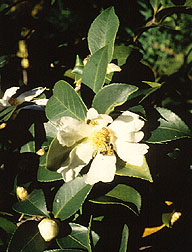This page has been archived and is being provided for reference purposes only. The page is no longer being updated, and therefore, links on the page may be invalid.
|
|
"Forgotten" Camellia Extends Flower’s Growing AreaBy Jill LeeOctober 23, 1998 Once, a plain white camellia traveled from the mountains of China to a famous American garden. It was relegated to the garden’s "lower path" and hidden behind its more colorful cousins. Terrible winters came. The homely but hardy camellia was among the garden’s few survivors. It became the progenitor of a cold-hardy dynasty of beautiful as well as winter-brave camellias. This is not an ancient fable, but a true story about a successful camellia breeding line from the U.S. National Arboretum. The arboretum, in Washington, D.C., is part of the Agricultural Research Service, the U.S. Department of Agriculture’s chief research agency. Fifty years ago, Chinese camellia seeds designated only as Plant Introduction 162475 were planted in the arboretum’s greenhouse. The idea was to add the plants to the arboretum’s extensive camilla collection. But the fall-blooming introduction, less showy than other lines, was soon forgotten. Harsh winters in 1977 and 1979 killed more than 950 camellias at the Arboretum--but not PI 162475. Arboretum breeder William Ackerman, now retired, began extensive cold-hardiness breeding and renamed PI 162475 as "Lu Shan Snow" after the seeds’ mountain origin. This variety--and another camellia Ackerman used--belong to the Camellia oleifera family, known for cold tolerance. Crossing them with lines having the colors and multiple petals consumers prefer led to a winter-ready dynasty that includes Winter’s Rose, Winter’s Waterlily and Ashton’s Pride. Camellias were once considered a perk of Southern living. Today, gardeners as far north as coastal Massachusetts enjoy them, thanks to Ackerman’s breeding efforts. The story of Lu Shan Snow appears in the October issue of Agricultural Research, ARS’ monthly magazine. The story also is on the World Wide Web at: /is/AR/archive/oct98/snow1098.htm Scientific contact: Thomas S. Elias, U.S. National Arboretum, ARS, Washington, D.C., phone (202) 245-4539, fax (202) 245-4574, telias@ars-grin.gov. |

